Quantum Mechanical Coherence of K+ Ion Wave Packets Increases Conduction in the KcsA Ion Channel
Abstract
:1. Introduction
2. Materials and Methods
2.1. General Methods
2.2. Classical MD Simulations
2.3. Quantum Mechanical Simulations
3. Results
3.1. Classical MD Simulations
3.2. Quantum Mechanical Motion of a K+ Ion
3.2.1. Coherence of the Wave Function
3.2.2. The Effect of QM Coherence on K+ Conductance
3.3. Temporal Characteristics
4. Discussion
Supplementary Materials
Author Contributions
Funding
Conflicts of Interest
Appendix A
Appendix A.1. Numerical Parameters of the Particles and of the Selectivity Filter
| Particle A | Particle B | dAB [pm] | frep,AB (Units of kBT/dAB) | Comment |
|---|---|---|---|---|
| K+ | K+ | - | - | Very strong Coulomb repulsion, no additional repulsion needed |
| K+ | O (central charge) | 131 | 500 | This repulsion hardly comes to play, because the K+ remain on the central axis of the SF. |
| K+ | O (lone pairs charge) | 248 | 100 | Plays an important role for keeping a K+ coordinated at a site. |
| K+ | H2O | 192.5 | 1000 | Determines how close an H2O can get attached to a K+ while following it through the SF. |
| O (central charge) | H2O | 137.5 | 500 | This repulsion hardly comes to play, because the H2O molecules remain on the central axis of the SF. |
| O (lone pairs charge) | H2O | 137.48 | 350 | Represents an occasional barrier for an H2O to pass on, depending on how it is oriented. |
| H2O | H2O | 137.5 | 500 | The Coulomb force acts between the three charges of each H2O. The distance for repulsion is given by the distance between the charge centers. |
Appendix A.2. Additional Aspects about MD Simulations
Appendix A.3. Additional Aspects of Quantum Mechanical Simulations
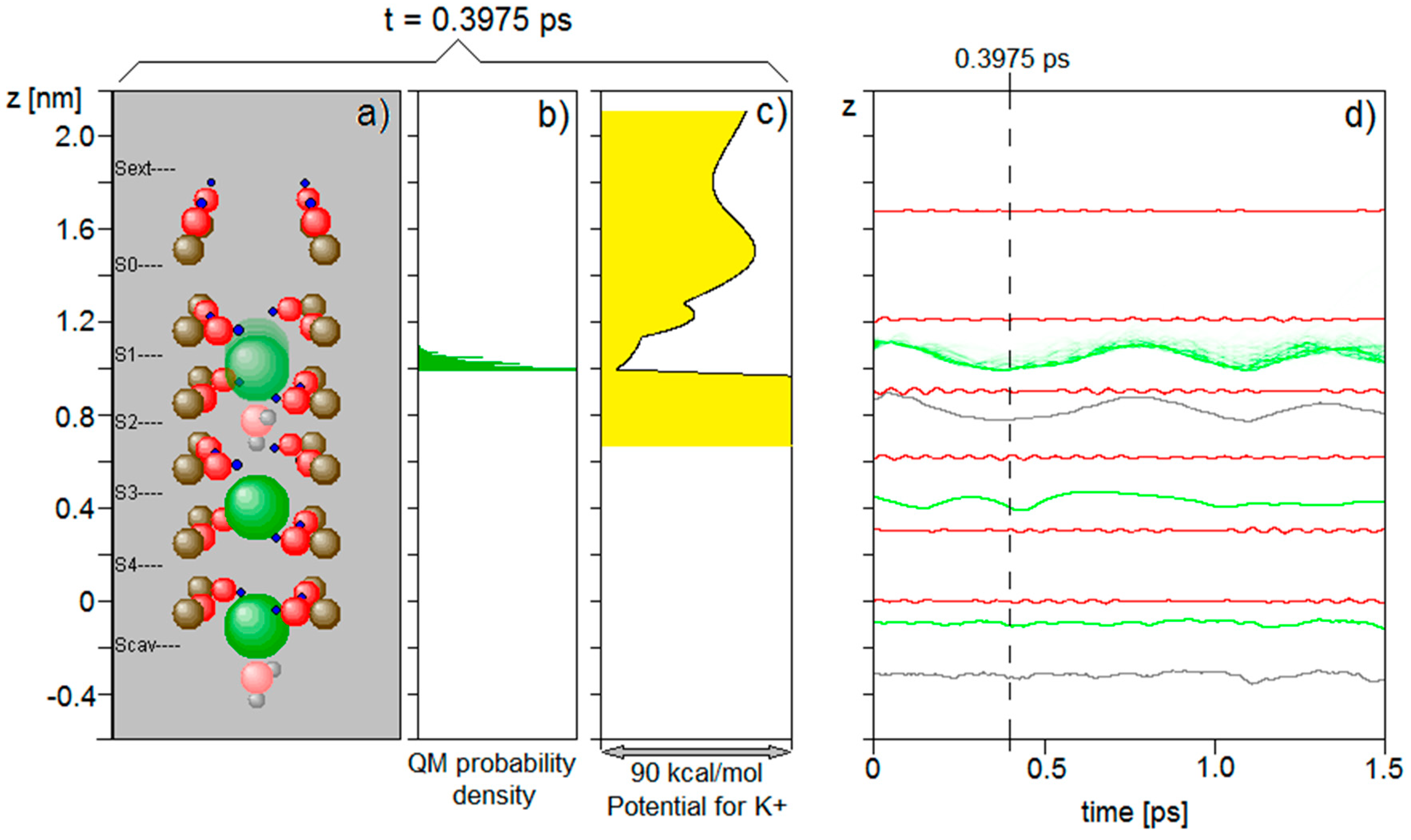
Appendix A.4. Coherence Calculation
References
- Hille, B. Ion Channels of Excitable Membranes, 3rd ed.; Sinnauer Associates: Sunderland, MA, USA, 2001. [Google Scholar]
- Kuyucak, S.; Andersen, O.S.; Chung, S.H. Models of permeation in ion channels. Rep. Prog. Phys. 2001, 64, 1427–1471. [Google Scholar] [CrossRef]
- Doyle, D.A.; Cabral, J.M.; Pfuetzner, R.A.; Kuo, A.; Gulbis, J.M.; Cohen, S.L.; Chait, B.T.; MacKinnon, R. The structure of the potassium channel: Molecular basis of K+ conduction and selectivity. Science 1998, 280, 69–77. [Google Scholar] [CrossRef] [Green Version]
- Morais-Cabral, J.H.; Zhou, Y.; MacKinnon, R. Energetic optimization of ion conduction rate by the K+ selectivity filter. Nature 2001, 414, 37–42. [Google Scholar] [CrossRef]
- Chattopadhyay, A.; Kelkar, D.A. Ion channels and D-amino acids. J. Biosci. 2005, 30, 147–149. [Google Scholar] [CrossRef]
- Bostick, D.L.; Brooks, C.L., III. Selectivity in K+ channels is due to topological control of the permeant ion’s coordination state. Proc. Natl. Acad. Sci. USA 2007, 104, 9260–9265. [Google Scholar] [CrossRef] [Green Version]
- Summhammer, J.; Sulyok, G.; Bernroider, G. Quantum Dynamics and Non-Local Effects Behind Ion Transition States during Permeation in Membrane Channel Proteins. Entropy 2018, 20, 558. [Google Scholar] [CrossRef] [Green Version]
- Furini, S.; Domene, C. Atypical mechanism of conduction in potassium channels. Proc. Natl. Acad. Sci. USA 2009, 106, 16074–16077. [Google Scholar] [CrossRef] [PubMed] [Green Version]
- Gwan, J.-F.; Baumgaertner, A. Cooperative transport in a potassium ion channel. J. Chem. Phys. 2007, 127, 045103. [Google Scholar] [CrossRef] [PubMed]
- Koepfer, D.A.; Song, C.; Gruene, T.; Sheldrick, G.M.; Zachariae, U.; de Groot, B.L. Ion permeation in K+ channels occurs by direct Coulomb knock-on. Science 2014, 346, 352–355. [Google Scholar] [CrossRef] [Green Version]
- Fowler, P.W.; Abad, E.; Beckstein, O.; Sansom, M.S.P. Energetics of multi-ion conduction pathways in potassium ion channels. J. Chem. Theory Comput. 2013, 9, 5176–5189. [Google Scholar] [CrossRef]
- Sansom, M.S.; Shrivastava, I.H.; Bright, J.N.; Tate, J.; Capener, C.E.; Biggin, P.C. Potassium channels: Structures, models, simulations. Biochim. Biophys. Acta (BBA) Biomembr. 2002, 156, 294–307. [Google Scholar] [CrossRef] [Green Version]
- Zhou, Y.; Morais-Cabral, J.H.; Kaufman, A.; MacKinnon, R. Chemistry of ion coordination and hydration revealed by a K+ channel–Fab complex at 2.0 Å resolution. Nature 2001, 414, 43–48. [Google Scholar] [CrossRef] [PubMed]
- Verlet, L. Computer “Experiments” on Classical Fluids. I. Thermodynamical Properties of Lennard−Jones Molecules. Phys. Rev. 1967, 159, 98–103. [Google Scholar] [CrossRef]
- Ponder, J.W.; Case, D.A. Force Fields for Protein Simulations. Adv. Protein Chem. 2003, 66, 27–85. [Google Scholar]
- Iwamoto, M.; Oiki, S. Counting Ion and Water Molecules in a Streaming File through the Open-Filter Structure of the K Channel. J. Neurosci. 2011, 31, 12180–12188. [Google Scholar] [CrossRef]
- Crank, J.; Nicolson, P. A practical method for numerical evaluation of solutions of partial differential equations of the heat conduction type. Math. Proc. Camb. Phil. Soc. 1947, 43, 50–67. [Google Scholar] [CrossRef]
- Kopec, W.; Rothberg, B.S.; de Groot, B.L. Molecular mechanism of a potassium channel gating through activation gate-selectivity filter coupling. Nat. Commun. 2019, 10, 5366. [Google Scholar] [CrossRef] [Green Version]
- VanDongen, A.M.J. K channel gating by an affinity-switching selectivity filter. PNAS 101 2004, 9, 3248–3252. [Google Scholar] [CrossRef] [Green Version]
- .Summhammer, J.; Sulyok, G.; Bernroider, G.; Cocchi, M. Forces from Lipids and Ionic Diffusion: Probing Lateral Membrane Effects by an Optimized Filter Region of Voltage Dependent K+ Channels (Preprint 2020). Available online: https://www.researchgate.net/publication/339616148_Forces_from_Lipids_and_Ionic_Diffusion_Probing_lateral_membrane_effects_by_an_optimized_filter_region_of_voltage_dependent_K_channels (accessed on 20 June 2020).
- Schlosshauer, M. Decoherence, the measurement problem, and interpretations of quantum mechanics. Rev. Mod. Phys. 2005, 76, 1267–1305. [Google Scholar] [CrossRef] [Green Version]
- Salari, V.; Moradi, N.; Fazileh, F.; Shahbazi, F. Quantum Decoherence Timescales for Ionic Superposition States in Ion Channels. arXiv 2015, arXiv:1410.7304v1. [Google Scholar]
- Salari, V.; Naeij, H.; Shafiee, A. Quantum Interference and Selectivity through Biological Ion Channels. Sci. Rep. 2017, 7, 4162. [Google Scholar] [CrossRef] [PubMed] [Green Version]
- Qaswal, A.B. Magnesium Ions Depolarize the Neuronal Membrane via Quantum Tunneling through the Closed Channels. Quantum Rep. 2020, 2, 5. [Google Scholar] [CrossRef] [Green Version]
- Maris, H.J. Electrons in Liquid Helium. J. Phys. Soc. Jpn. 2008, 77, 111008. [Google Scholar] [CrossRef]
- Berneche, S.; Roux, B. A gate in the selectivity filter of potassium channels. Structure 2005, 13, 591–600. [Google Scholar] [CrossRef] [PubMed] [Green Version]
- Martin, F.; Zipse, H. Charge distribution in the water molecule—A comparison of methods. J. Comput. Chem. 2005, 26, 97–105. [Google Scholar] [CrossRef]
- Ridgeway Scott, L.; Fernandez, A. A Mathematical Approach to Protein Biophysics; Springer: Berlin/Heidelberg, Germany, 2017; p. 121. [Google Scholar]
- Garofoli, S.; Jordan, P.C. Modelling permeation energetics in the KcsA potassium channel. Biophys. J. 2003, 84, 2814–2830. [Google Scholar] [CrossRef] [Green Version]
- Furini, S.; Domene, C. Computational studies of transport in ion channels using metadynamics. Biochim. Biophys. Acta 2016, 1858, 1733–1740. [Google Scholar] [CrossRef]
- Noskov, S.Y.; Bernéche, S.; Roux, B. Control of ion selectivity in potassium channels by electrostatic and dynamic properties of carbonyl ligands. Nature 2004, 431, 830–834. [Google Scholar] [CrossRef]
- Feenstra, K.A.; Hess, B.; Berendsen, J.C. Improving efficiency of large time-scale molecular dynamics simulations of hydrogen rich systems. J. Comp. Chem. 1999, 20, 786–798. [Google Scholar] [CrossRef]
- Chung, S.H.; Corry, B. Conduction Properties of KcsA Measured Using Brownian Dynamics with Flexible Carbonyl Groups in the Selectivity Filter. Biophys. J. 2007, 93, 44–53. [Google Scholar] [CrossRef] [Green Version]
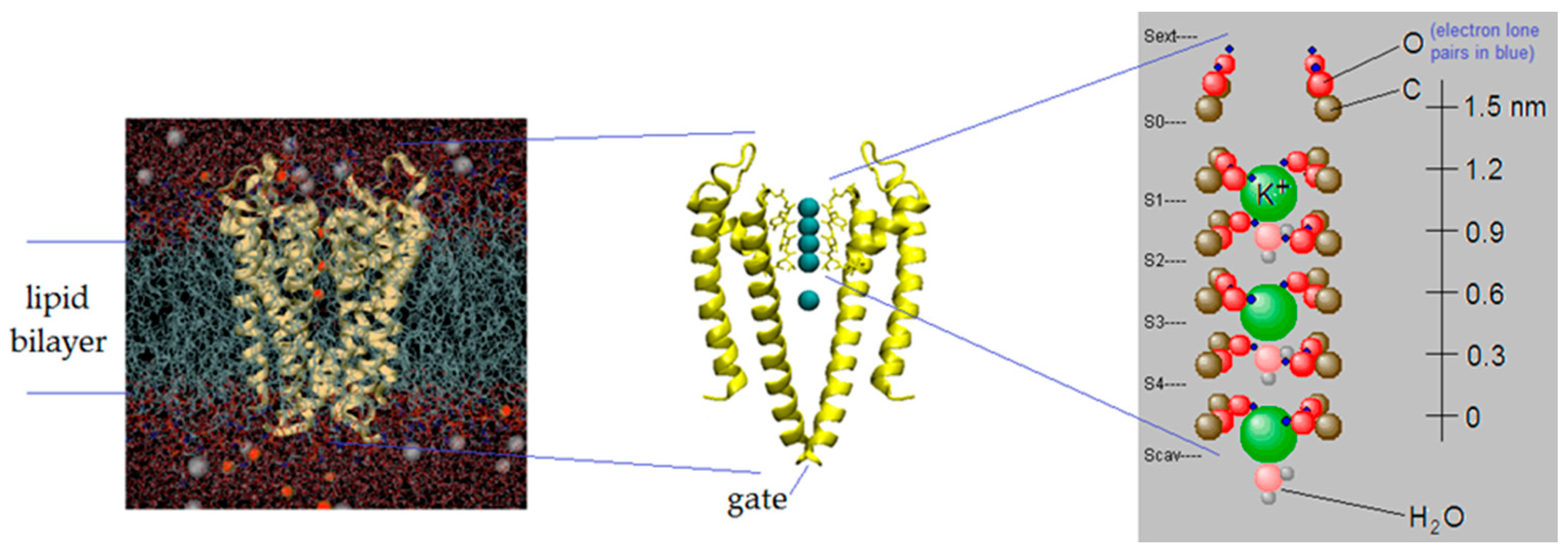
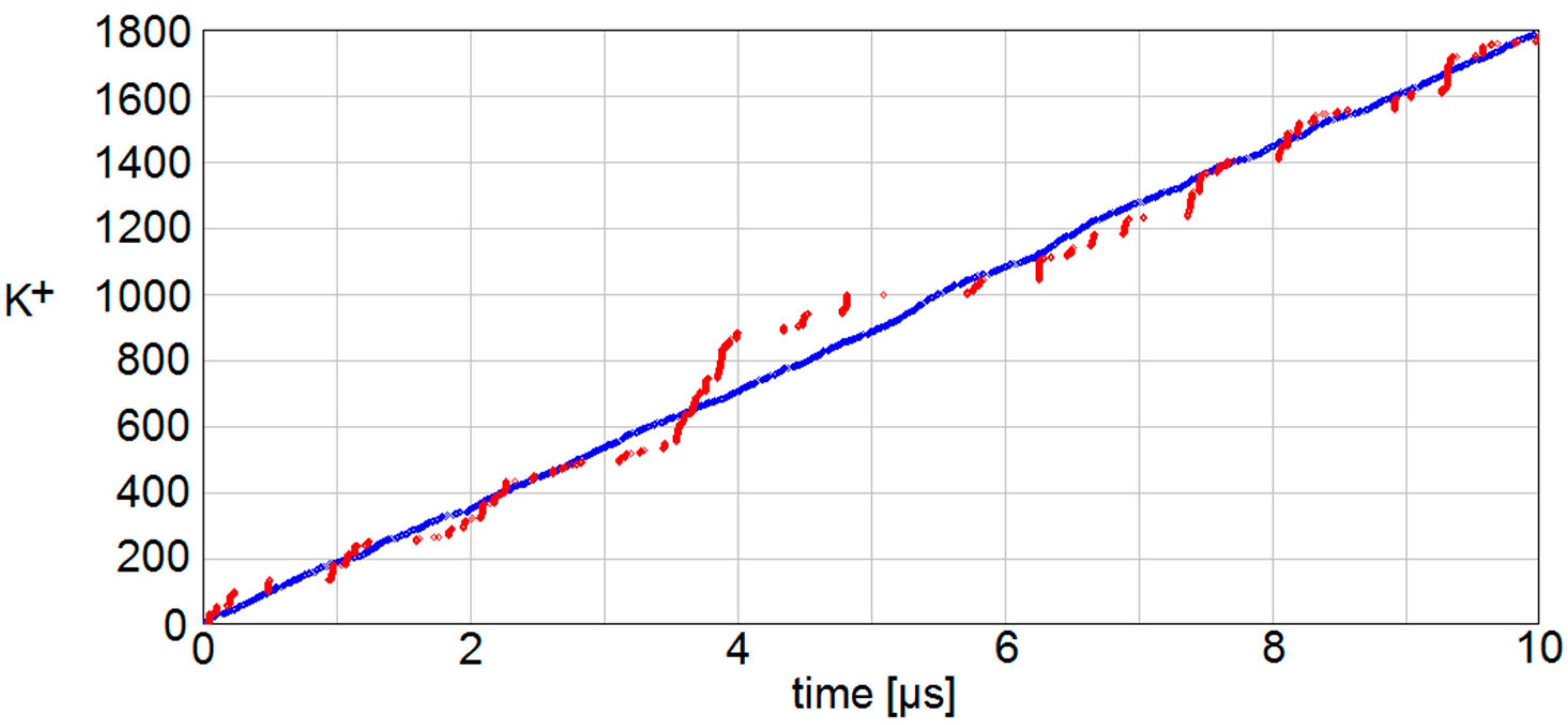
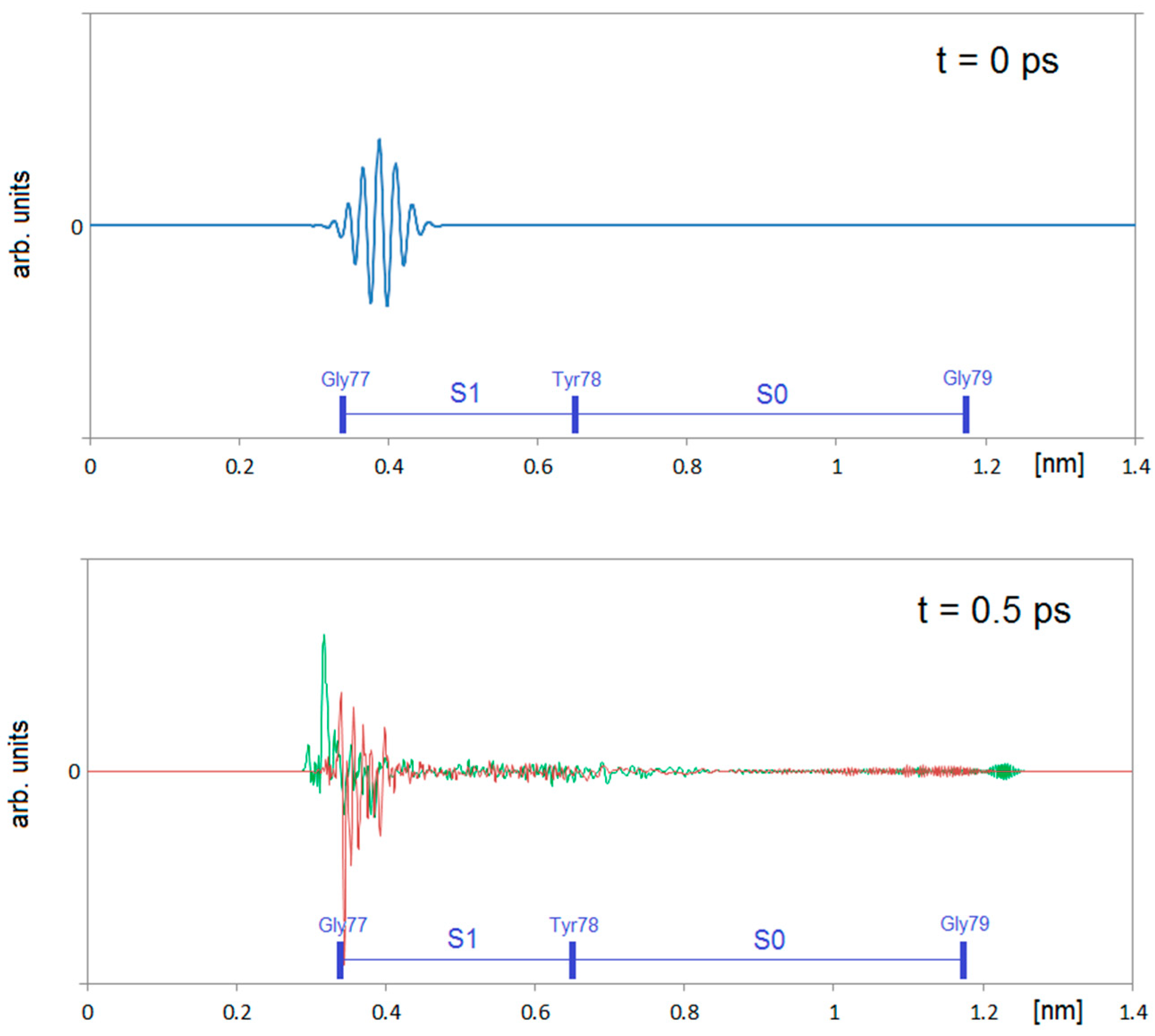
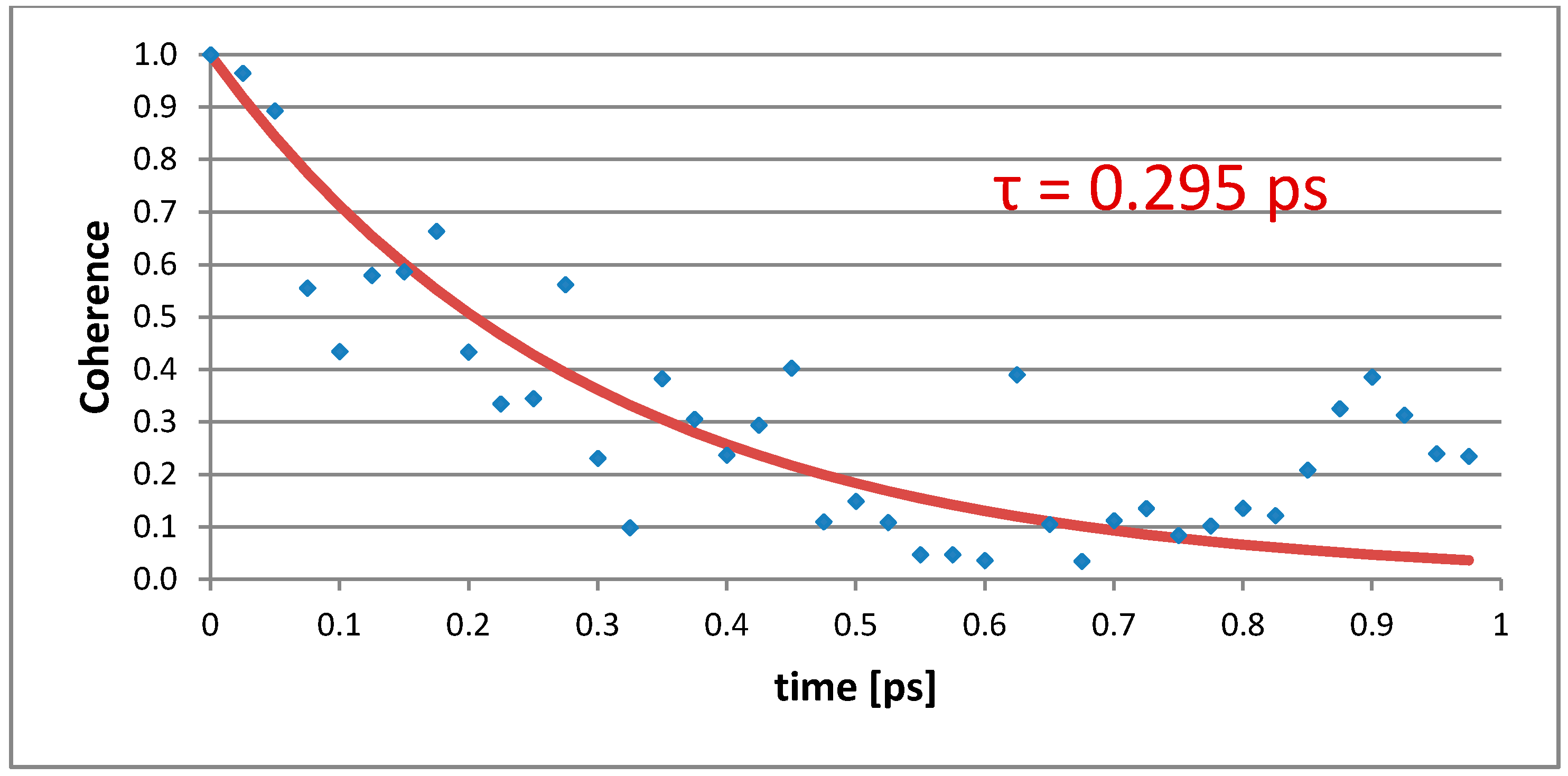
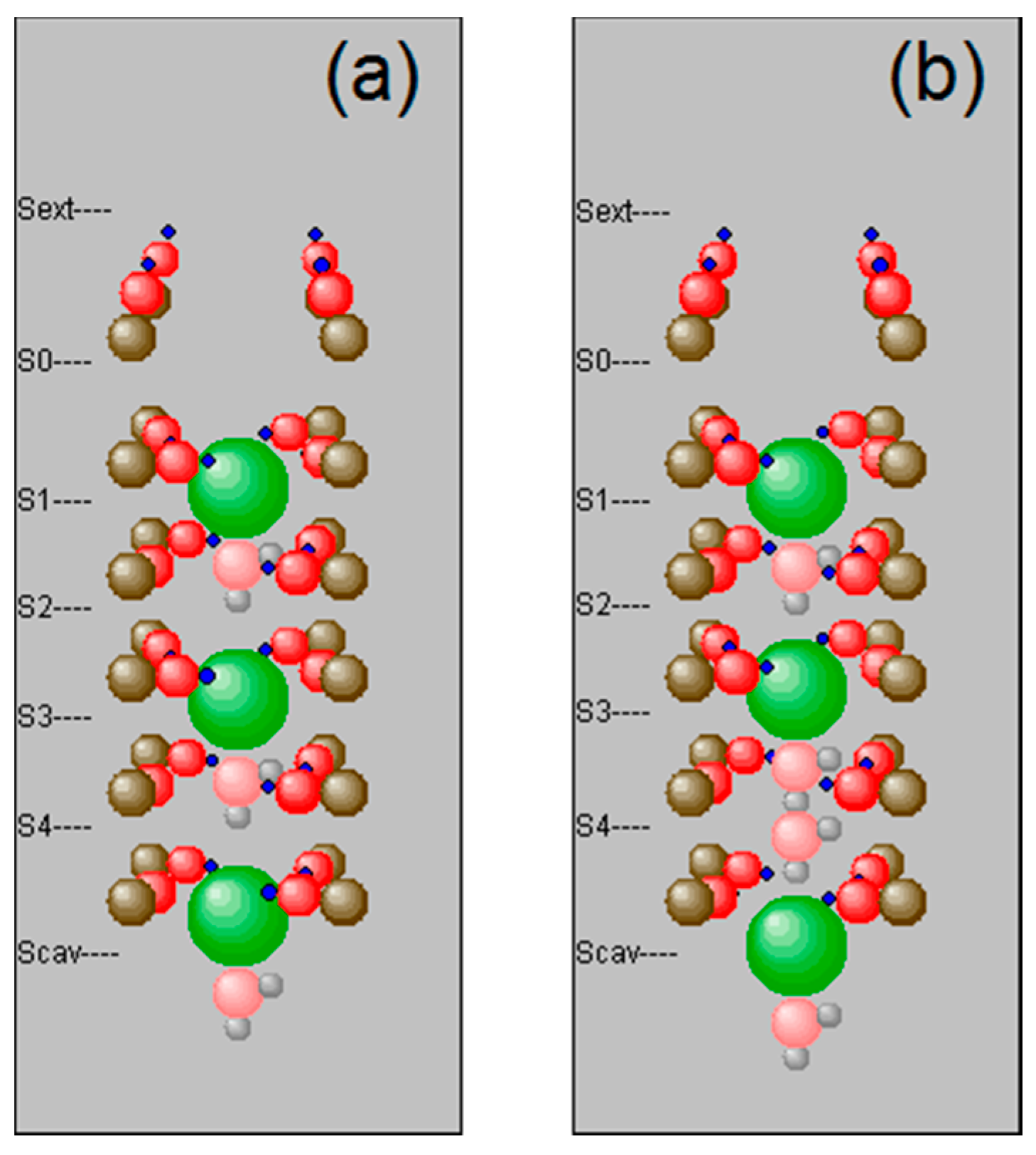
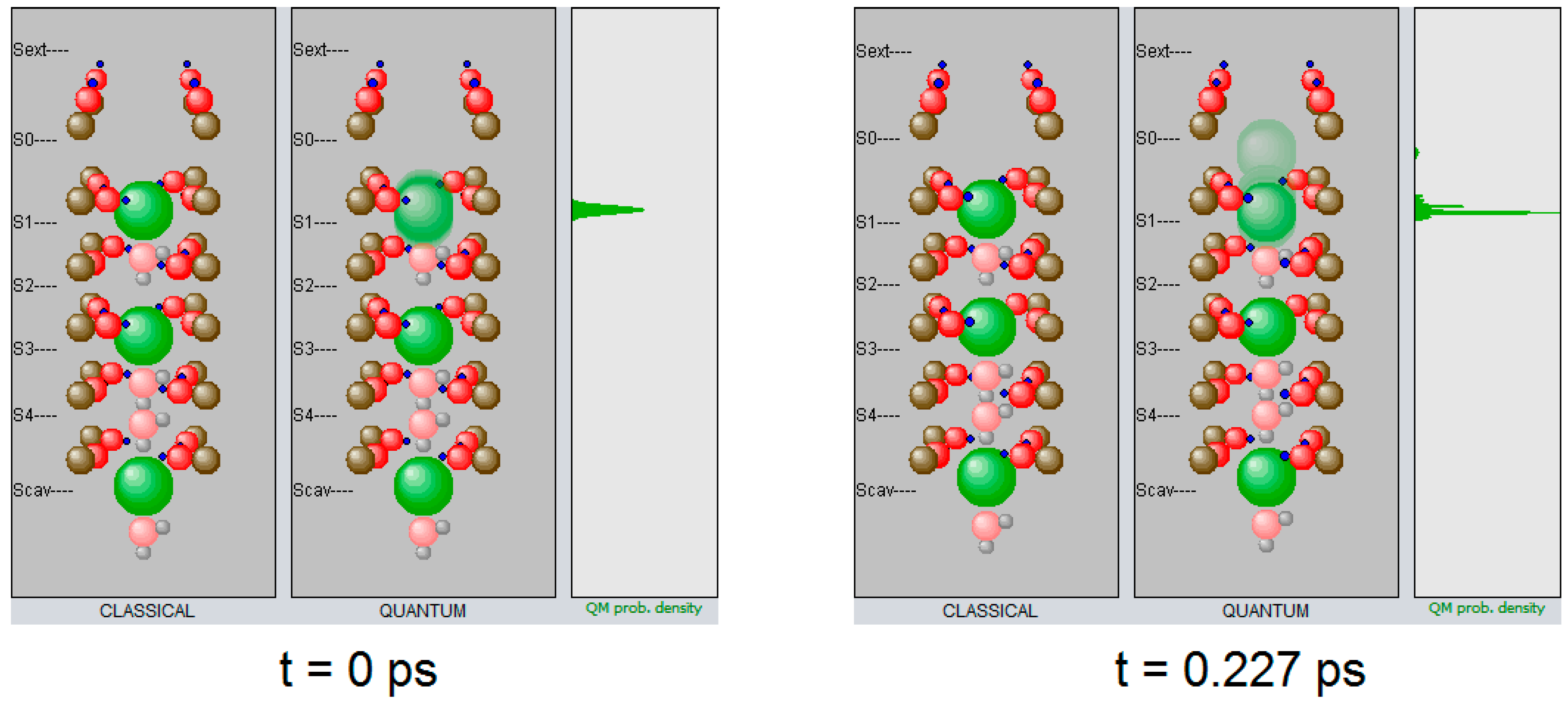
© 2020 by the authors. Licensee MDPI, Basel, Switzerland. This article is an open access article distributed under the terms and conditions of the Creative Commons Attribution (CC BY) license (http://creativecommons.org/licenses/by/4.0/).
Share and Cite
Summhammer, J.; Sulyok, G.; Bernroider, G. Quantum Mechanical Coherence of K+ Ion Wave Packets Increases Conduction in the KcsA Ion Channel. Appl. Sci. 2020, 10, 4250. https://doi.org/10.3390/app10124250
Summhammer J, Sulyok G, Bernroider G. Quantum Mechanical Coherence of K+ Ion Wave Packets Increases Conduction in the KcsA Ion Channel. Applied Sciences. 2020; 10(12):4250. https://doi.org/10.3390/app10124250
Chicago/Turabian StyleSummhammer, Johann, Georg Sulyok, and Gustav Bernroider. 2020. "Quantum Mechanical Coherence of K+ Ion Wave Packets Increases Conduction in the KcsA Ion Channel" Applied Sciences 10, no. 12: 4250. https://doi.org/10.3390/app10124250
APA StyleSummhammer, J., Sulyok, G., & Bernroider, G. (2020). Quantum Mechanical Coherence of K+ Ion Wave Packets Increases Conduction in the KcsA Ion Channel. Applied Sciences, 10(12), 4250. https://doi.org/10.3390/app10124250






